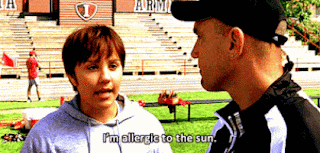1. Identify the main message of the PSA.
As it says in the
picture, “you are not a sketch, say no to anorexia.”
2. Analyze the creative strategies to convey the message of
the PSA.
a. What is the concept?
People, specifically
women, wanting to be as thin as what they see in the sketch causing them to be
anorexic.
b. What is the design?
An extremely thin, bony
woman doing a pose exactly the same as the sketch next to it. Very simple, but
gives a strong message.
c. How were the concepts and design realized effectively?
The message being
portrayed is made obvious causing a person to immediately know what the PSA is
about.
3. Find out the technical requirements necessary to
construct the PSAs.
a. What equipment were used?
Photoshop and the pad
people use for sketching in a computer.
b. What elements make up the production design?
The sketch of a model,
the actual model, and the phrase that says “You are not a sketch. Say no to
anorexia.”
c. Were photographic/cinematographic special effects used?
Yes, photographic
special effects were obviously used. (Photoshop)
4. Evaluate how the creativity of the PSA relates to the
social dimension of the public messages.
a. Is the PSA evocative and "entertaining"?
Yes, the PSA was
evocative because when I first saw the photo, it made me feel sad that there
really are people who don’t eat anymore because of the fear of being fat.
b. Does the entertainment value of the PSA take away or add
to the seriousness of the message?
If by “entertaining”
meaning enjoyable or amusing, then no it does not add to the seriousness but it
takes it away. This is a matter that isn’t supposed to be taken lightly.
c. Does the PSA build on stereotypes that may be
unnecessarily discriminating against a certain class of people?
Maybe to people who are
opposite to anorexic people. Those who actually want to BE fat. But then again,
I honestly don’t think it unnecessarily
discriminates anyone.
d. Does the PSA build on positive ideas or emotions?
It tells people who
suffer from anorexia, as well as those who think they’re fat that they’re not a
sketch so there’s no need for them to have that ideal type of body.
e. Does the PSA build on negative ideas or emotion?
I don’t think so.
Although the only negative idea here is the thought of not eating anything
anymore.
f. What are the
effective and ineffective aspects of appealing to the positive or negative
ideas and emotions vis-a-vis particular public service messages?
The most effective
aspect for me was the skinny woman posing exactly like the sketch of a model.
Again, there were no negative aspects in the photo.
5. Determine the target audience of the PSA.
a. Which audience needs to see the PSA?
Those who suffer from
anorexia, people who are too insecure about their body, who think they’re too
“fat”.
b. What visual or aural conventions/strategies were used to
appeal to a particular audience?
An ultra-thin woman
being compared to a mere sketch of a model.
c. Do these visual or aural conventions/strategies add to a
deeper understanding or emotional appeal to the PSA?
Yes,
very much. It shows the negative effect of when women don’t eat anything
anymore just to achieve their “body goals”.
Women, including men,
must eat and maintain their health. Eating less, once a day, or nothing at all,
WOULD make you thin but will put your body on a lot of stress. You would get
even more depressed than you are now. Eating at least 3 - 6 times a day, having
a proper diet and exercise is a healthy way of losing those so-called “fats”.
Losing fat isn’t easy, there’s no shortcut to fat loss (Unless you go through
liposuction obviously... but do you really want needles and knives cutting your
body?) The thing is, maybe you’re not at all fat. You just think you are. When
people try to put you down by saying things like “you should lose weight”, “you
got fat what happened to you”, “it’s a shame that you’re fat, you could’ve been
pretty”, and other useless, “BS” nonsense, don’t listen to any of it. Put a
smile on your face, tell them to mind their own business (you didn’t ask for
their opinion anyway), beat them to a pulp (only in your head, not physically J),
then flip your hair and turn away. Always remember...
YOU ARE NOT A SKETCH.
SAY NO TO ANOREXIA.










































